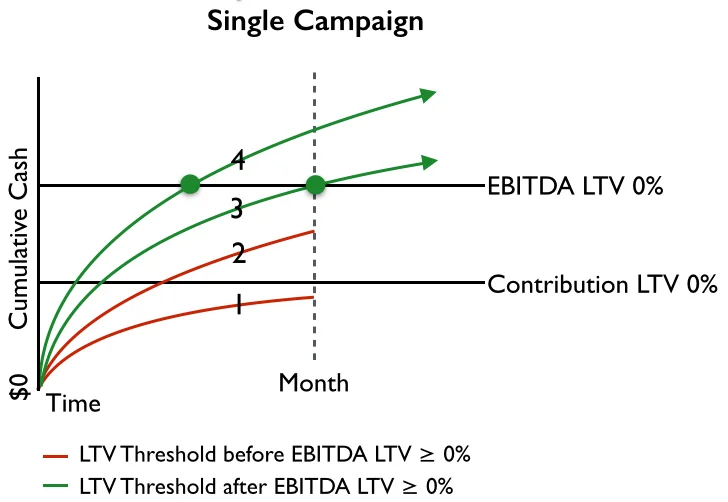We've previously discussed the importance of analyzing marketing cohorts from the perspective of lifetime value. One of the main constraints for assessing cohort profitability thresholds deals with defining your maximum LTV payback period. You can use this information to create rules for marketing campaign optimization.
LTV threshold defines optimization strategy
Your LTV threshold defines the maximum duration in which your business can look at LTV's for a particular cohort before you run out of money. It is a function of your cumulative cash position, or the amount of cash you generate from sales, the amount of cash you burn on overheads, and the amount of external cash (i.e. investor funding) you hold.
Once your business-wide LTV threshold is defined, you can judge each of your marketing campaigns against your cohort profitability thresholds of:
- Paying back for marketing spend
- Paying back proportional overhead spend
Differences in each marketing campaign's cohort layering momentum's will guide you with one of four marketing optimization strategies, as per the single campaign plot above.
- Your campaign doesn't pay for itself within your LTV threshold. You should kill this campaign as the cohort doesn't layer fast enough to pay for itself. Alternatively you can optimize this campaign towards profitability.
- Your campaign pays for itself, but not for proportional overheads within your LTV threshold. Depending on how close you are to EBITDA breakeven, you should optimize this campaign towards profitability. If you can't optimize the campaign, kill it.
- Your campaign pays for itself and its proportional overheads within your LTV threshold. You should optimize this campaign to profit sooner, but you should not kill it at this LTV threshold. If you have no better campaign opportunities, you should scale this campaign.
- Your campaign pays for itself and its proportional overheads before you meet your LTV threshold. You should attempt to scale this campaign, as it pays for itself and overheads before your LTV threshold. Investing your resources in growing this type of campaign will extend your runway.
All of these scenarios reiterate the positive impact of improving your cohort layering momentum, as unprofitable campaigns can turn profitable through stimuli from re-engagement activities that improve your cohort decay rate.
WHEN DO YOU GROW THE UNPROFITABLE 1%?
As I mentioned in a previous post, 99% of the time the answer to "how to expand the business" is by growing profitable cohorts (campaigns 3 & 4). However, at times you may need to employ strategic marketing moves that may not have cohort based monetary justification (campaigns 1 & 2). Just because a cohort isn't generating revenue today doesn't mean it is worthless or not worth scaling.
- Your strategy is to "buy the market" in a move to force out a competitor. In this instance you're agreeing to sacrifice cohort quality in an aggressive move to prevent market access for your competitors.
- Your strategy is to improve your cohort layering momentum in order to eventually generate revenue faster from existing cohorts. As long as you have a plan for how to improve your metrics, this strategy is reasonably understood and supported by investors.
- Your strategy is to learn because you have little data or are entering nascent markets. Here your campaigns may not be profitable because you are making the case to test a new business model.
- You measure value through non monetary sources such as facebook likes, twitter retweets, pinterest pins etc. However, at a basic level even these metrics can be backed into a cohort LTV so proceed with caution.
- You have no better alternatives, and while you look for new ones you can't shut down acquisition efforts. This is a very tricky scenario that will lead to your business running out of money if you don't either improve your metrics or acquire cohorts less expensively.



